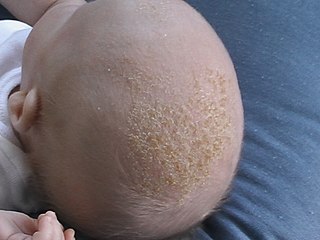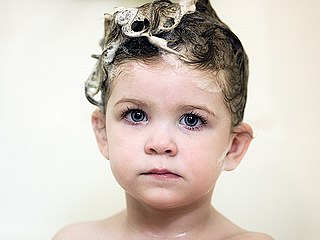
In chemistry, hydrophobicity is the physical property of a molecule that is seemingly repelled from a mass of water. In contrast, hydrophiles are attracted to water.

Observation in the natural sciences is an act or instance of noticing or perceiving and the acquisition of information from a primary source. In living beings, observation employs the senses. In science, observation can also involve the perception and recording of data via the use of scientific instruments. The term may also refer to any data collected during the scientific activity. Observations can be qualitative, that is, the absence or presence of a property is noted and the observed phenomenon described, or quantitative if a numerical value is attached to the observed phenomenon by counting or measuring.

Zinc pyrithione is a coordination complex of zinc. It has fungistatic and bacteriostatic properties and is used in the treatment of seborrhoeic dermatitis and dandruff.

Hair conditioner is a hair care cosmetic product used to improve the feel, texture, appearance and manageability of hair. Its main purpose is to reduce friction between strands of hair to allow smoother brushing or combing, which might otherwise cause damage to the scalp. Various other benefits are often advertised, such as hair repair, strengthening, or a reduction in split ends.

Polydimethylsiloxane (PDMS), also known as dimethylpolysiloxane or dimethicone, is a silicone polymer with a wide variety of uses, from cosmetics to industrial lubrication.

A hot tub is a large tub full of water used for hydrotherapy, relaxation or pleasure. Some have powerful jets for massage purposes. Hot tubs are sometimes also known as "spas" or by the trade name Jacuzzi. Hot tubs may be located outdoors or indoors.

Cradle cap causes crusty or oily scaly patches on a baby's scalp. The condition is not painful or itchy, but it can cause thick white or yellow scales that are not easy to remove. Cradle cap most commonly begins sometime in the first three months but can occur in later years. Similar symptoms in older children are more likely to be dandruff than cradle cap. The rash is often prominent around the ear, the eyebrows or the eyelids. It may appear in other locations as well, where it is called infantile seborrhoeic dermatitis. Cradle cap is just a special—and more benign—case of this condition. The exact cause of cradle cap is not known. Cradle cap is not spread from person to person (contagious). It is also not caused by poor hygiene. It is not an allergy, and it is not dangerous. Cradle cap often lasts a few months. In some children, the condition can last until age 2 or 3.
Selenium disulfide, also known as selenium sulfide, is a chemical compound and medication used to treat seborrheic dermatitis, dandruff, and pityriasis versicolor. It is applied to the affected area as a lotion or shampoo. Symptoms frequently return if treatment is stopped.
Artificial hair integrations, more commonly known as hair extensions, hair weaves, and fake hair add length and fullness to human hair. Hair extensions are usually clipped, glued, or sewn on natural hair by incorporating additional human or synthetic hair. These methods include tape-in extensions, clip-in or clip-on extensions, micro/nano rings, fusion method, weaving method, and wigs.

Hair care or haircare is an overall term for hygiene and cosmetology involving the hair which grows from the human scalp, and to a lesser extent facial, pubic and other body hair. Hair care routines differ according to an individual's culture and the physical characteristics of one's hair. Hair may be colored, trimmed, shaved, plucked or otherwise removed with treatments such as waxing, sugaring and threading. Hair care services are offered in salons, barbershops and day spas, and products are available commercially for home use. Laser hair removal and electrolysis are also available, though these are provided by licensed professionals in medical offices or speciality spas.
Nephrogenic diabetes insipidus, recently renamed as arginine vasopressin resistance (AVP-R) and also previously known as renal diabetes insipidus, is a form of diabetes insipidus primarily due to pathology of the kidney. This is in contrast to central or neurogenic diabetes insipidus, which is caused by insufficient levels of vasopressin. Nephrogenic diabetes insipidus is caused by an improper response of the kidney to vasopressin, leading to a decrease in the ability of the kidney to concentrate the urine by removing free water.

Carpet cleaning is performed to remove stains, dirt, and allergens from carpets. Common methods include hot water extraction, dry-cleaning, and vacuuming.

Sunsilk is a British hair care brand produced by the company Unilever. The brand was introduced in 1954 in the UK and available in most countries globally. It is a hair care brand in Southeast Asia.

Piroctone olamine is a compound sometimes used in the treatment of fungal infections. Piroctone olamine is the ethanolamine salt of the hydroxamic acid derivative piroctone was first synthesized in 1979 by Schwarzkopf-Henkel (Germany).

Ecotoxicity, the subject of study in the field of ecotoxicology, refers to the biological, chemical or physical stressors that affect ecosystems. Such stressors could occur in the natural environment at densities, concentrations, or levels high enough to disrupt natural biochemical and physiological behavior and interactions. This ultimately affects all living organisms that comprise an ecosystem.

Shampoo is a hair care product, typically in the form of a viscous liquid, that is used for cleaning hair. Less commonly, shampoo is available in solid bar format. Shampoo is used by applying it to wet hair, massaging the product into the scalp, and then rinsing it out. Some users may follow a shampooing with the use of hair conditioner.

A hair roller or hair curler is a small tube that is rolled into a person's hair in order to curl it, or to straighten curly hair, making a new hairstyle.
Khimera is a software product from Kintech Lab intended for calculation of the kinetic parameters of microscopic processes, thermodynamic and transport properties of substances and their mixtures in gases, plasmas and also of heterogeneous processes. The development of a kinetic mechanism is a key stage of present-day technologies for the creation of hi-tech devices and processes in a wide range of fields, such as microelectronics, chemical industry, and the design and optimization of combustion engines and power stations. Khimera with Chemical WorkBench, another software product from Kintech Lab, allows both the development of complex physical and chemical mechanisms and their validation. Essential feature of Khimera is its user-friendly interface for importing and utilizing the results of quantum-chemical calculations for estimating rate constants of elementary processes and thermodynamic and transport properties.

Dry shampoo otherwise known as hybrid shampoo is a type of shampoo which reduces hair greasiness without the need for water. It is in powder form and is typically administered from an aerosol can. Dry shampoo is often based on corn starch or rice starch. In addition to cleansing hair, it can also be used as a tool for hair-styling as it can create volume, help tease hair, keep bobby pins in place, and be used in place of mousse in wet hair. Dry shampoo proponents attest that daily wash-and-rinse with detergent shampoo can strip away natural oils from hair. However, others attest that spraying dry shampoo every day will lead to a build-up of product that can dull hair color and irritate the scalp, arguing that the scalp needs regular cleansing and exfoliating to get rid of bacteria, remove dead skin cells, and stay healthy.
Hair washing without commercial shampoo, sometimes called no poo, includes water-only hair washing or hair washing with non-commercial products, such as baking soda and vinegar. Advocates argue that commercial shampoo is an unnecessary expense and may contain harmful ingredients.













